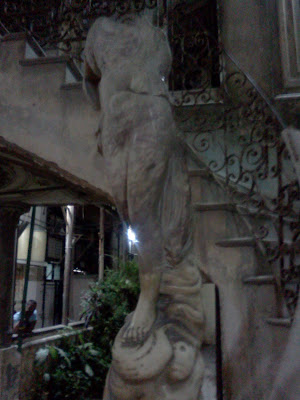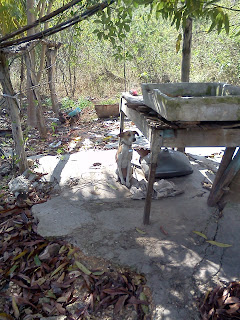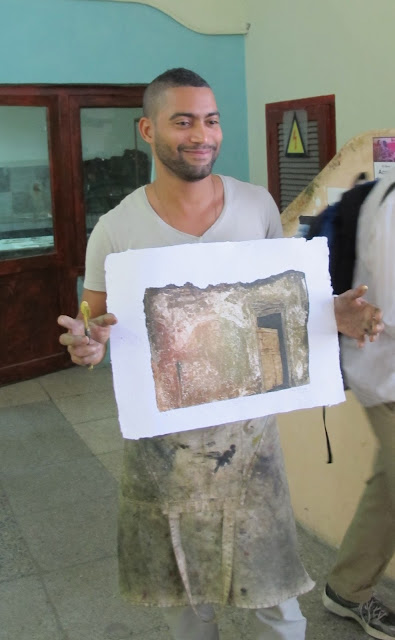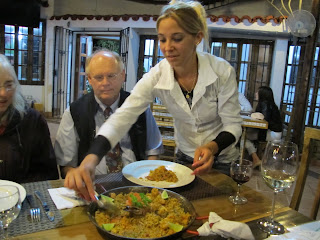Friday, March 1
 |
| Tobacco drying in a barn in Vinales, Cuba |
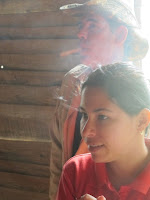 |
| Yuli in a cloud of cigar smoke |
Today we visited a tobacco farm, where we met the farmer. Since it was rainy and overcast, the farmer
took us inside his drying barn where he explained tobacco farming through our
noble guide and translator, Yuli. Of course the
farmer, who Joan thought looked like Antonio Banderas, was doing a terrific job
smoking one of his cigars. We thought we were going to lose our Yuli in the
cloud of smoke, but she soldiered on.
 |
| Showing us how to roll a cigar. |
We learned that it is the terroir
of the Cuban tobacco that makes it so famous.
The different grades or tobacco often come from the same plant. The lower and lesser leaves are picked for
cigarettes. Leaves further up the plant are
picked for cigar fillers and the best are used for cigar wrappers. “Antonio” explained that the leaves are
sprayed with a combination of honey and rum, among other things! We watched him roll some cigars where we
learned how important is the wrapping of the cigar.
A group of us (not Joan) purchased a bundle
from “Antonio,” and later when smoking them, we could see how some were better
constructed than others in the batch by the draw of the smoke.
 |
| Cigars rolled and pressed for us in Cuba. |
 |
| David enjoying a hand-rolled Cuban cigar |
Though nice, these cigars did not compare to
the fancy ones we got in Habana, especially for the draw. We might add that the farmer’s bundle, cost
about $2 each, and the fancy ones cost $8
to $10 each and would be about $25 in Canada.
 |
| Mogotes near Vinales in Cuba. |
After the farm, we drove into the Parque Nacional Vinales, an area of very interesting rock formations, called mogotes, very similar to those found in China. The ground is basically flat, but rising out
of the ground are limestone formations, like huge haystacks, with rounded tops
and very sheer sides.
Unfortunately it was still drizzling and the clouds were low, so we did not have the opportunity to see the scenery in all it's spectacular grandeur, but we think our pictures evoke drawings of similar landscapes in China.
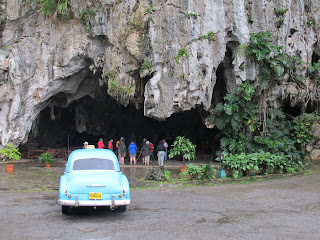 |
| Entrance to Palenque de los Cimarrones |
There are several
well-known caves in the rock formations that have become popular places for tourists
to visit. Most of our group visited one
cave, called Palenque
de los Cimarrones, while those of us who were averse to touristy kitsch or
enclosed spaces waited in the bus and read while we listened to our driver Abel’s
great music.
Our next spot was the Mural de la Prehistoria, where we had lunch. There were
three choices . . . and great mjiotos and pina coladas and beer! This dining area was in full view of the mural,
a huge garish painting done right on the side of one of these interesting
formations in the 1960s by a follower of Diego Rivera. The huge snail, dinosaurs, sea monsters and
humans represent an artistic vision of evolution, all in psychedelic colors. It attracts a lot of tourists to the little
restaurant.
 |
| The psychedelic Mural de la Prehistoria near Vinales, Cuba |
 |
| Disconcerting doll head |
 |
| At the Jardin de Caridad, Vinales, Cuba |
After lunch, we headed into the town of Vinales, where we saw a very interesting
private garden, El Jardin de Caridad, created by two sisters now passed away
but continued by their assistants. For a donation, we toured this sprawling
garden that was a century in the making. In addition to orchids and many other
local varieties of flowers, bushes and trees, we saw folk sculpture made from
dolls heads, beer cans and metal salvage.
Fun.
 |
| At the Jardin de Caridad, Vinales, Cuba |
Then we walked around the town of Vinales, trying to mingle with the locals. (We stood
out).
There were a couple of small art galleries, a common thread in Cuba,
and we bought a small print of the colorful red tile rooftops we saw in
Habana. We also tried, and survived
eating some tasty chocolate doughnut-like fried street snacks.
 |
| Street food: Meringues and chocolate donuts! |
There was a small queue in front of the
Government store. Cubans go here to buy
many staples – if they have them.
Interesting retail – no displays, not even stock showing, whatever. I guess you just have to ask, and if they have
it, you can get it for a fixed price. It
is almost as bad as the Pennsylvania State Liquor Store system in the 1970s –
but this is for staples, not evil spirits.
 |
| Town square in Vinales, Cuba with the obligatory statue of Marti |
Of course there is always the black market. We asked our guide Yuli
about this – where is the black market?
Everywhere she said, as she gestured with a sweep of her arm-- it’s
pervasive, all over Cuba. Do you suppose some off what was in those big
poly-wrapped bundles we saw at the Miami
Airport was black market supplies?
Dinner was back at the hotel, and this was the first time that we saw
musicians that were a bit of a disappointment; they didn’t seem as polished as the
others we had seen.
 |
| Cute kitty in the tree at Rancho San Vicente |
There were some cute cats up in the tree just off the
dining porch, that, though perched high (to avoid the dogs probably), knew how
to work the crowd, especially Joan, who was a soft touch. We had three choices
for dinner…and afterwards didn’t sit around the pool, as it was cold and we
were all bundled in all the warm clothes we’d brought with us. Steve did teach us about the warming
qualities of aged rum though, and we found it was a good antidote to the chill.
Saturday, March 2
After another buffet breakfast at the hotel, we departed Vinales and
headed for the Zapata Peninsula. Our destination was Playa Larga at the upper
tip of Bahia Cochinos – The Bay of Pigs.

This trip involved quite a bit of highway driving and was our longest
day in the bus. Cuban highways are not
too busy for the simple reason that not a lot of people have cars. The busses
are not new but rather well used, which is polite-talk for almost always
crowded. In the countryside, in lieu of
busses, we saw old trucks fitted with benches that were also overflowing. There is another time-honored system of
getting around in Cuba:
hitchhiking. Often we saw men standing
by the roadside and instead of a projecting thumb, they were holding out peso
notes. There is sort of an unofficial
fare for some rides. Finally, on the
four lane highways we were using today at major entrances, we saw officials
wearing yellow jackets, los amarillos,
coordinating rides. Apparently
government vehicle are obliged to stop and give people a lift, facilitated by los amarillos. Though it was a four lane highway, horse carts, bicycles and pedicabs
shared the space with trucks, busses and cars.
Especially at entrances, pedestrians were casual about jaywalking across
all four lanes. We asked Yuli about this
safety issue, and she told us that it is a big problem, though everything
looked fairly orderly to us.
 |
| Hotel Playa Larga individual room-a great cottage! |
We arrived at the Hotel Playa Larga to find our rooms were actually
separate buildings, small art-deco cottages about the size of the average Cuban
house (which are small by our standards). That reminded us of 1940s suburban
housing developments in America. Our cottage had a big living room, decent
bath and good size bedroom – no creatures though. The porch was great for having a late night
rum and cigar.
Our first appointment was with Frank Medina, the director of Cienega de Zapata National Park. He explained that Cuba is about 110 square kilometers
and has a population of about 11 million people, 3 million of whom live in
Habana.
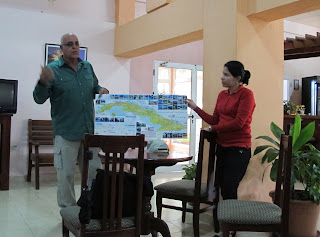 |
| Cienega de Zapata National Park Director with our guide Yuli. |
Cuba has 290 natural beaches, including
our Playa Larga, and about 100 protected areas.
The island
is also home to 15 natural parks, 6 biospheres and 2 World Heritage sites. Cienega de Zapata
National Park is about 5,000
square kilometers. He said it is the
most important wetlands in the Caribbean, and host to a variety of mammals including
dolphins and manatees, four kinds or rats, bats, feral cats and dogs, cows,
horses, dolphins, the occasional farmer, and of course tourists. Reptiles are not to be forgotten, ranging
from the Cuban crocodile, tortoises to a variety of snakes. Of special interest
to some our group was the fact that of the 365 birds to be seen in Cuba,
256 of them can be found in Zapata. Dr.
Medina also said there were over 1,000 species of plants here, many of them
endemic. In addition to orchids, ferns
and epiphytes, there are important trees, such as the ash, known to make good
baseball bats.
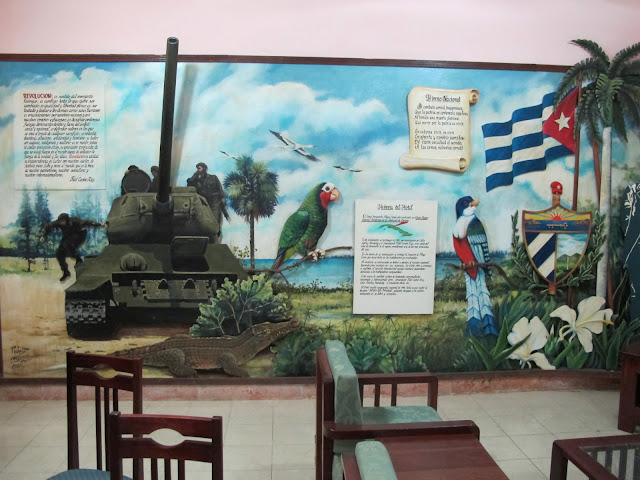 |
| Mural at Hotel Playa Larga on the Bay of Pigs, Cuba |
The area also has a problem with invasive species; about the only ones
they were really successful in eradicating were the freedom fighters sponsored
by the CIA who came into the Bay of Pigs in
1961. Yuli tells us that one of the
reasons the invasion, which Cubans call LaVictoria de Playa Giron, failed was the
freedom fighters expected support from
the local inhabitants. But in the years between Castro’s revolution in 1958 and
the invasion in 1961, the Castro Communist government steered education and
health care resources to the countryside the locals had not seen during the
Batista years. She said that most of the
locals decided they were better off under Castro.
 |
| Monument to a fallen Cuban defender at the Bay of Pigs |
Throughout the area, we saw monuments
to the soldiers who died in that battle, and the hotel had quite a 3-D wall
mural giving their side of the battle.
We were disappointed not to have the chance to visit the museum about
the invasion at Playa Giron, which we learned was very interesting.
Before dinner, we went for a walk on the beach and rocky shoreline,
which was overflowing with flotsam and jetsam, but we spotted some starfish,
lots of sea urchins and sweet striped fish in the shallow tidepools.
 |
| Tidepooling at Playa Larga on the Bay of Pigs |
Some of us (even Dane!) donned our swim suits
and went for a swim in the Bay of Pigs. It was
very shallow at Playa Larga, so we could wade out for many yards and only have
the warm water come up to our waists.
 |
| Swimming (well, waltzing) in the Bay of Pigs |
 The thatched beachside bar was our pre-prandial gathering point for
mojitos, aged rum and cerveza.
The thatched beachside bar was our pre-prandial gathering point for
mojitos, aged rum and cerveza.
 |
Seeing the sun come out on Playa Larga Cuba after several days of clouds.
|
And glory
be, the setting sun poked its way through the clouds and we were hopeful for
improved weather after several days of grey skies, drizzle and cold.
 |
| "It's lovely rice pudding for dinner again |
Dinner, again with good live musicians, was fine. One of the things about the Cuban menu is that the plates become a “study in white,” rice, potato, pork chop, chicken or fish . . . .and surprise, it’s lovely rice pudding for dessert again!
 |
| The evidence of a night well smoked. |
Dane enjoyed sitting
on the porch with his cigar buddies smoking their cigars and sipping rum while
Joan retreated inside to the fresh air to read another good book called Cuba Diaries by Isadora Tattlin.





